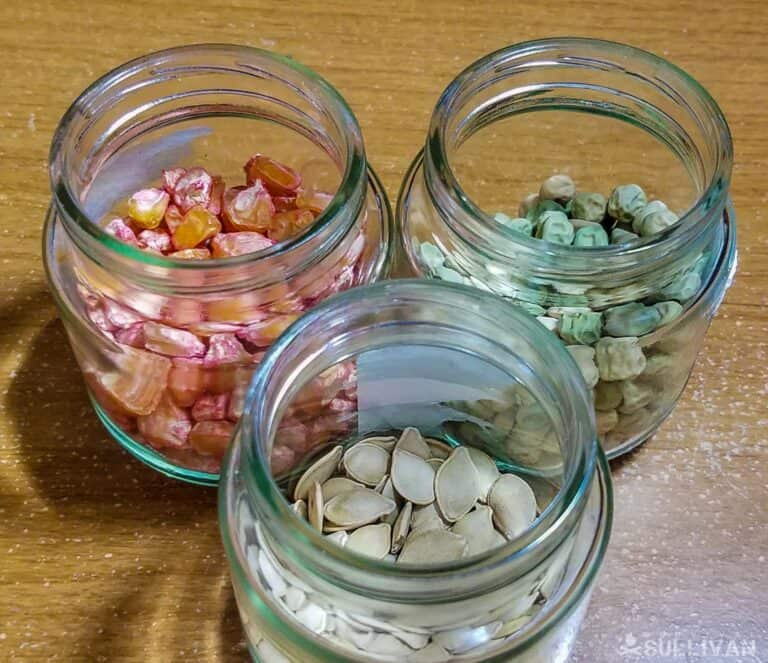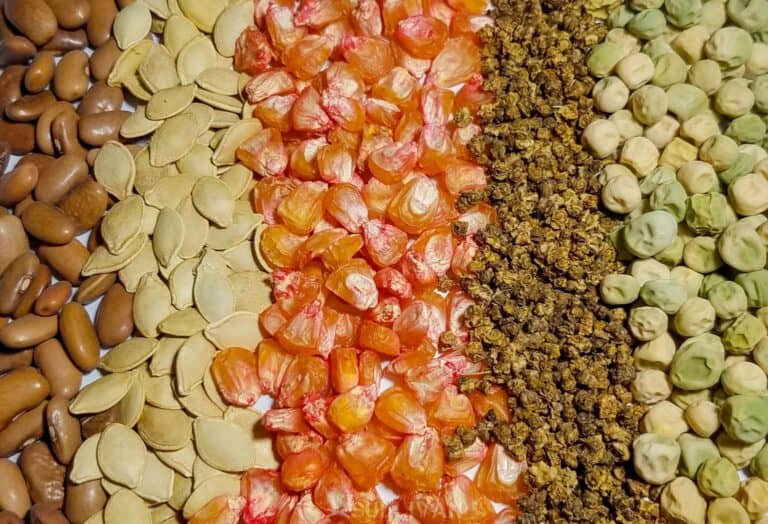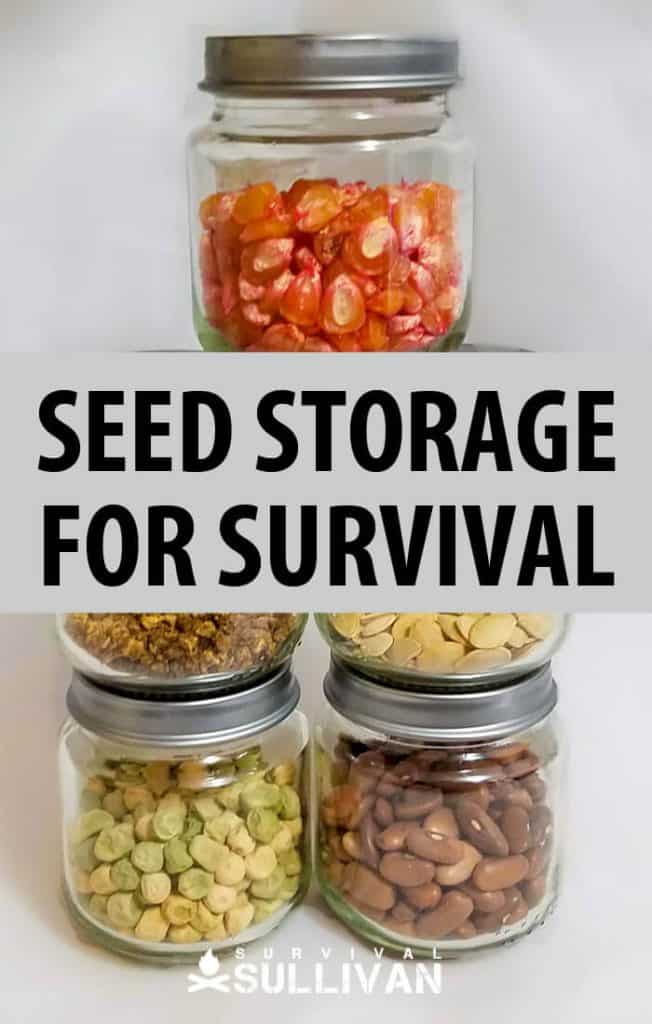We’ve got our survival gardens growing, have learned to can and preserve our produce but, there is still another way that we can prep using our gardens.

Seed storage is the practice of saving and storing seeds from your vegetables at the end of the growing season. This serves a number of purposes.
It allows you to continue your garden into the next year without buying more seeds; it allows you to share seeds with friends and family to encourage them to prep as well; and you can also create a seed bank.
This collection of seeds is designed to provide a variety of food sources preserved for an uncertain future. If we have an economic collapse, or farming is drastically affected by climate change, these seeds would allow you to start over, and help your neighbors to start again.
Why Store Seeds?
Seed storage is becoming more vital by the day as large companies produce genetically modified seed that is designed not to reproduce, forcing gardeners and farmers to buy new seed each year, and making us reliant on those seed companies because they hold the patents on the use and distribution of their GM seeds.
This threat to food security is why there is a movement back to heirloom open-pollinated seeds so we can be sure that the seed we keep from year to year is suited to the growing conditions and has adapted to the area.
This way we can store seed and remain independent of large corporations knowing that we have sufficient seed should SHTF when we can no longer afford to buy seed, or it is not readily available.
Heirloom seeds can be purchased online or you can obtain from friendly neighbors, or save seed when you buy heirloom produce at farmers’ markets or certified organic stores.
Before you start saving seeds it is worthwhile knowing the three factors that can affect seed storage:
- Humidity
- Warmth
- Age
Humidity is enemy number one as it can cause mold to grow, destroying the seed. Heat can shorten a seed’s shelf life. Age can be a factor for some seeds as after a couple of years the rate of germination will drop.
However, the oldest seed that germinated was in 2005, when a 2000 year old Judean date palm seed, that had been discovered in Herod the Great’s Palace in Masada, Israel, actually grew. It is now around three metres tall and doing well, the only one in existence of an extinct variety.
The seed had been kept in a cool, dry place all those years, showing just how resilient nature can be.
Even older is a 32 000 year old seed that needed some scientific intervention for the plant to grow. An ice age squirrel had buried the seed from Silene stenophylla, a flowering plant native to Siberia.
The seed was encased in ice until it was discovered under the permafrost together with various bones of extinct animals like the woolly mammoth. Russian scientists, using tissue from the seeds, managed to grow the plant successfully.
This just goes to show that the seeds, can be grown many years later – although 2 000 years might be pushing it a bit!
Norway has a Doomsday Vault, also known as the Svalbard Global Seed Vault, a long-term seed storage facility where seeds from the world’s crops are kept frozen, near to the Arctic Circle.
Ideally, seed needs to be stored below 50 degrees Fahrenheit, which is why many people put their seed into the refrigerator or a freezer, however in case of SHTF scenarios where you cannot do this, storing seed sealed into a glass jar and buried in a cool spot will work.
If you are planning on using the seed the next year you do not have to go to such extreme measures.
Simply make sure the seed is dry, place in paper packets noting the type of seed and the date it was harvested, then place in a glass jar with a properly sealed lid and keep in a cool dark place, or place in the refrigerator.
The viability of most vegetable seed is between one and five years. Check out this quick table to know how long common seeds will last under ideal or close to ideal conditions:
| Seed Yype | Shelf Life |
|---|---|
| basil | 5 years |
| tomato, squash, turnips, watermelon, sage | 4 years |
| asparagus, fennel, spinach, peas, lettuce, celery, soybean, catnip, daisy, carrot, | 3 years |
| lovage, sweet corn, parsley | 2 years |
You can find even more seeds’ shelf lives here. Remember that these are mere guidelines for optimum germination.
Check out this video to see how 10-year-old seeds germinate:
If you have the time you can use the same method to check germination rates:
Count out 10 seeds and place them on warm damp paper towels on a tray, cover with more warm damp paper towel and then with an old towel, as you see in the video.
Check how many germinate out of 10 – lets’s say 5 germinate, then you have a 50% germination rate.
Personally, I would just plant the seed in the ground and see how it does. I have planted sunflower seed that had been ‘forgotten’ in a glass jar in a garden shed for well over 10 years and had around 60% germination rate.
Planning
First and foremost, you will have to make some adjustments to your garden before you can start saving your seeds. Your garden will need to be completely comprised of open-pollinated, non-hybridized, non-GMO seeds.
In order to start saving your seeds, you will have to make plans starting one year in advance.
When you hit the store or web to purchase your seeds in the spring, be sure to pick up only heirloom seeds. Then you will actually have a viable product to save at the end of the season.
For your first season you will either have to purchase seeds from a commercial grower or have friends that can donate heirloom seeds to your garden.
There are plenty of reputable online companies that can provide quality heirloom seeds for survival purposes. You might also want to consider a prepackaged seed bank that provides a variety of these seeds. Sometimes this is the most cost effective way to get what you need.
You should select which seeds to save based on two factors. The obvious one is to choose based on the fruits and vegetables that you are most likely to eat or trade, as there is no point in producing food that will go to waste.
The second factor is starting with the seeds that are easiest with which to work. These are going to be self-pollinated seeds.

Types of Seeds
Self-pollinated seeds are by far the easiest to store and grow. These include green beans, lima beans, green peppers, chili peppers, eggplant, tomatoes, peas, lettuce, chicory, peanuts, and endive.
Self-pollinated seeds are also the easiest to work with because they do not have to be pollinated by another plant.
The plant fertilizes itself when pollen from the male anthers of the flower adhere to the female stigma for successful fertilisation, which happens through movement in the wind.
If you want to help pollination along you can shake the flowers gently to encourage the transfer of pollen from the anther to the stigma.
Self-pollinating plants eliminate the risk of cross-pollination or accidental hybridization. You should get exactly the same product year after year with these seeds.
Wind tranferance over distance and insect pollinated seeds are not so simple.
They require a little more effort from the grower to keep the product pure. These plants can accidentally be pollinated by other plants located up to a mile away. This can create accidental hybridization that can ruin the purity of your veggies or fruit.
The grower can either hand-pollinate the plants to prevent these issues, or they can create distance or barriers to prevent hybridization. However, there are certain misconceptions regarding cross- pollination that need to be cleared up.
Cross pollination only occurs between varieties – so you may have a certain variety of tomato and your neighbor another variety – these may cross pollinate, however a busy bee collecting pollen cannot cause a cross pollination between two species – so you can’t get a tomato mixed with a cucumber for example.
Cross pollination will only affect your seed saved – so the next year you may get a mixed variety of tomato when you plant the seed but it will not affect the current crop.
There is one exception to this however and that is corn, where the current ears of corn will be slightly different if they have been cross pollinated.
This is why when corn experiments are being carried out the stands will be placed far away from other corn to avoid that risk, however in a home garden this is not possible so the other way is to use different days-to-maturity varieties.
So you’ll plant a corn that takes around 65 days or less to maturity and then one that take around 110 days to maturity to avoid the chance of cross pollination.
Yukon Chief Sweet corn takes just 55 days, making it one of the earliest varieties.The ears produced are just 6 to 8 inches in length and are yellow and sweet.
Plants such as squash, radish, spinach, corn, and cucumber will produce seeds the same year, so you can harvest seed to keep for the next year or two.
Where things get really complicated is when you get into biennial vegetables. These veggies do not produce a viable seed until the year after their first growing season. That means that you must overwinter the plants to ensure that they are still thriving the second year.
Plants in this category include carrots, onions, cabbage, beets, leeks, celery, swiss chard, and turnips. For root vegetables in this category you cannot harvest the first year at all, so it takes some planning.
Drying and Freezing
Different types of seeds will last different lengths of time. For best storage you want to dry any seed down to less than 7% moisture and then keep it frozen in temperatures below 0 F.
The lower the temperature, the longer the seed will last. Some will last over ten years, while others need to be used right away.
For example, radishes must be used within a year. Peas, corn, and tomatoes typically last about three to five years. These are called Orthodox seeds.
There are groups of seeds that must be planted quickly called intermediate and recalcitrant seeds. Recalcitrant seeds are tropical and include coconut, tea, and mangoes, which must be planted immediately.
Intermediate seeds can be partially dried to save for a few months, but are not ideal for seed banks. These would include coffee and papayas.
Be sure to store them in proper containers to maximize their shelf life.
Rotation
Many of us practice food rotation with our food storage. This means that we date our frozen foods and our canned goods and always use the oldest food first to keep from wasting any of it. This same principle must apply to seed banks.
If you assume that the average seed will last four years properly frozen, then you can store seeds from four years of harvest. Then you need to plant the oldest seeds and save the rest.
By annually planting your oldest seeds and bringing in a brand new batch, you ensure that your seeds will last as long as possible if you are forced to rely upon your seed bank.
Remember that keeping the seeds frozen at a low temperature is paramount to maintaining their viability. If you are in a situation where power is limited, you must find a way to keep your seeds frozen.
If you have a generator, using your power for this purpose is a good idea. If you do not have a consistent source of power, you have four options.
You can either move your seeds to another location with a working freezer, you can trade them for other goods, you can plant them, or you can take your chances with keeping them in a closed container in a cool dry spot.
After all the first Americans and early settlers had no refrigeration, yet managed to save their seed and plant from year to year. Many of the old time farmers kept their vegetables seed in packets in a biscuit tin in the back of a cupboard – dark, dry and relatively cool.
In Conclusion
If you want to take your gardening efforts to the next level, seed storage for a seed bank is a great step. It takes some planning and a little extra effort, but can make a huge difference with your SHTF strategy.
Not only do you learn more about agronomics and save money on seeds, but you give yourself the opportunity to start a small scale vegetable farm if the situation requires it.
Imagine if everything falls apart, yet you have the supplies to turn your whole property into a vegetable garden. Not only could you easily feed your family, but you would have plenty of supplies to can, dry, or freeze.
You would also be able to trade your goods with others in the area to help improve your overall supplies. I hope we have given you enough reasons to do more research and decide if a seed bank is right for you.


My name is Ryan Dotson and I am a survivalist, prepper, writer, and photographer. I grew up in the Ozark Mountains and in the foothills of the Pocono Mountains. My interest in survival started when I was in Boy Scouts and continued as my father, uncle, and grandfather taught me to hunt and fish. In the last few years I have started taking on survival challenges and have started writing about my experiences. I currently live in Mid-Missouri with my wife Lauren and three year old son Andrew.
